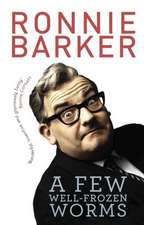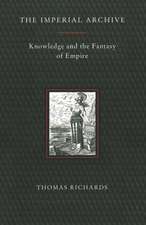The Meaning of Star Trek: An Excursion Into the Myth and Marvel of the Star Trek Universe
Autor Thomas Richardsen Limba Engleză Paperback – 30 iun 1999
"I feel differently. I think the meaning of the series can best be captured by looking at how it successfully creates a coherent universe. Like any great work of art or literature, the Star Trek universe has an integrity and a resonance all its own, a completeness unrivaled by any other kind of science fiction, whether movie, television show, or novel. The unique character of the series, taken not as a group of loosely connected stories but as a viable whole, is the subject of this book."
--From the Introduction to The Meaning of Star Trek
Star Trek has no equal. Easily the most cerebral show on television, it brought a literary sophistication to the raw material of science fiction and confounded all the formulas of television. By taking classic stories and placing them in strange new contexts, Star Trek became a modern Odyssey in outer space, a set of stories so basic to our culture that they can be told over and over again.
The Meaning of Star Trek captures the essence of this timeless television masterpiece by linking the parallel universes of classical literature and popular culture. Thomas Richards examines its portrayals of contact and conflict with other species and other cultures; its deep explorations of character and identity, and its complex conception of the idea of the individual self; its remarkably rich and varied use of story and myth; and its profound appeal to our shared sense of wonder, a reverence and awe for that which science cannot explain.
Enlightening, provocative, and enormously entertaining, The Meaning of Star Trek is essential reading for even the most casual admirer of the Star Trek universe, as well as a brilliant introduction to the worlds of literature, myth, and science fiction.
This book was not prepared, approved, licensed, or endorsed by any entity involved in creating or producing the Star Trek television series or films.
Preț: 88.25 lei
Nou
Puncte Express: 132
Preț estimativ în valută:
16.89€ • 17.67$ • 14.03£
16.89€ • 17.67$ • 14.03£
Carte tipărită la comandă
Livrare economică 03-17 aprilie
Preluare comenzi: 021 569.72.76
Specificații
ISBN-13: 9780385484398
ISBN-10: 0385484399
Pagini: 208
Dimensiuni: 140 x 224 x 14 mm
Greutate: 0.27 kg
Editura: Main Street Books
ISBN-10: 0385484399
Pagini: 208
Dimensiuni: 140 x 224 x 14 mm
Greutate: 0.27 kg
Editura: Main Street Books
Recenzii
"Richards' analysis is excellent and covers everything from theology to the emphasis on individualism that lies at the very heart of the Star Trek universe."
--Kirkus Reviews
--Kirkus Reviews
Notă biografică
Thomas Richards is a former associate professor of English and American Literature at Harvard University. He is the author of two works of nonfiction as well as a novel, Zero Tolerance. A Guggenheim fellow, he lives in California.
Extras
A space station turning to a Richard Strauss waltz. A small ship making its approach to the station like a partner in a dance. For me the most visually remarkable moment in science fiction has always been the space ballet in Stanley Kubrick's 2001: A Space Odyssey (1968). In this film Kubrick shows the station, shaped like a double wheel, spinning in place as it orbits the earth. The station does not dominate the screen. It is a small island of life in the vast quiet desolation of space. As Kubrick sees it, the technology of human beings clearly pales in comparison with the earth, sun, moon, and stars. Human beings are by no means the masters of the universe. They move around in it slowly, hampered by weightlessness, trapped in space suits, and hooked up to respirators. In many ways 2001: A Space Odyssey accords with what astronauts of all nations have been telling us for years: that space is a cold and empty place.
In Star Trek space is anything but empty. In all of Star Trek there is nothing like the space ballet scene in Kubrick's movie. A comparable scene from the first Star Trek movie makes a clear point of comparison. In this movie Captain James T. Kirk and his reunited crew are shown approaching the revamped Enterprise. The space station and the starships fill the screen. Human figures are strongly in evidence. Kirk and the crew are seen watching from windows. The scene reflects the general attitude of the series toward space: at every turn Star Trek is full of the presence of life in outer space. The desolate quality of outer space imagined by Kubrick and experienced by our astronauts plays a relatively minor role in the series. Instead space serves as a landscape, beautiful and distinctly pictorial, a background for human activity and intensely human concerns. The most visually memorable scenes in Star Trek take place on particular planets or on board the Enterprise itself. From time to time the crew of the Enterprise confronts purely empty space, but there is nothing in the series to rival the space ballet of 2001: A Space Odyssey.
Rather, the Star Trek universe is a noisy and populated place. Stanley Kubrick calls his movie "a space Odyssey," and true to his title, he gives us a vision of space like that of Homer's poem the Odyssey. The Odyssey tells the story of a single hero, Odysseus, trying to get home after fighting in the Trojan War. But on his way back Odysseus gets lost in the Mediterranean Sea. Kubrick bases his story of a lone astronaut lost in space on Homer's story of a single man in a small ship lost alone at sea. Though Star Trek certainly has some elements of the Odyssey in it (I will be looking at them later), the series more often resembles the world of Homer's other epic, the Iliad. Homer's Iliad is an epic about diplomacy and the uneasy rivalries of different races, the Greeks and the Trojans, who fight the Trojan War on the coastal plains of what is now Turkey. The Iliad shows the Mediterranean to be not an empty and desolate world but a populated world full of wars, rivalries, and divine and human passions. In many ways Star Trek is "a space Iliad," not "a space Odyssey." The series shows a Federation of planets slowly expanding into the outer reaches of the universe, where, more often than not, it confronts not emptiness and desolation but a bewildering array of other forms of life.
The Star Trek universe, then, is full of races of different kinds of beings. This may seem a very simple assumption, but it is not an assumption that every work of science fiction makes. Isaac Asimov's Foundation series imagines a future in which human beings colonize a galaxy that turns out to be empty and inhospitable. Star Trek begins with the fact and problem not just of other life in the universe but of compatible life in the universe and never takes it for granted. Space is never completely alien. In all of Star Trek there is nothing like the scenario depicted in the movie Alien, which shows a space freighter drifting out of reach from human contact, faced only with the frightening otherness of a completely malignant nonhuman being. Even when a starship is magically transported to a different part of the galaxy, as in the newest series, Star Trek: Voyager, space turns out to be very much inhabited and full of M-class planets. The map of the galaxy seen in the series shows a great swirling wheel of stars divided into territory controlled by Klingons, Romulans, Cardassians, Ferengi, and Borg. The universe is full of empires old and new and the Federation and its colonists are always getting into trouble with them. Many of its best episodes deal with the conflict of cultures resulting from the Federation's relentless expansion into outer space.
The Star Trek stories of contact and conflict with other species typically follow three different scenarios. In the first scenario the Federation is considerably more powerful than a primitive or underdeveloped society. The Enterprise and its crew are mistaken for gods and are often drawn into rituals playing out the death of a god as part of some sort of religious festival. The first Star Trek series almost always draws on this scenario of first contact, which places the crew of the Enterprise in the position of explorers during the our own age of discovery in the sixteenth and seventeenth centuries. In the second scenario the Federation finds itself at rough parity with the forces of other empires. Relations with the Klingons, Romulans, and Cardassians follow this pattern. The second Star Trek series tends to specialize in these kinds of plots, where interstellar tension is lessened through the best efforts of the Federation's master diplomat, Captain Jean-Luc Picard. In the third scenario the Federation is inferior and its very existence is threatened. The best movies and novels in the science fiction genre, from H.G. Wells's The War of the Worlds to Arthur C. Clarke's Childhood's End to the movie Alien, consistently follow this scenario, which dislocates the position of human beings in the universe, and Star Trek is no exception. The story of first contact with the Borg, told in a trilogy of remarkable episodes, may well be ranked among the greatest achievements of science fiction.
In Star Trek space is anything but empty. In all of Star Trek there is nothing like the space ballet scene in Kubrick's movie. A comparable scene from the first Star Trek movie makes a clear point of comparison. In this movie Captain James T. Kirk and his reunited crew are shown approaching the revamped Enterprise. The space station and the starships fill the screen. Human figures are strongly in evidence. Kirk and the crew are seen watching from windows. The scene reflects the general attitude of the series toward space: at every turn Star Trek is full of the presence of life in outer space. The desolate quality of outer space imagined by Kubrick and experienced by our astronauts plays a relatively minor role in the series. Instead space serves as a landscape, beautiful and distinctly pictorial, a background for human activity and intensely human concerns. The most visually memorable scenes in Star Trek take place on particular planets or on board the Enterprise itself. From time to time the crew of the Enterprise confronts purely empty space, but there is nothing in the series to rival the space ballet of 2001: A Space Odyssey.
Rather, the Star Trek universe is a noisy and populated place. Stanley Kubrick calls his movie "a space Odyssey," and true to his title, he gives us a vision of space like that of Homer's poem the Odyssey. The Odyssey tells the story of a single hero, Odysseus, trying to get home after fighting in the Trojan War. But on his way back Odysseus gets lost in the Mediterranean Sea. Kubrick bases his story of a lone astronaut lost in space on Homer's story of a single man in a small ship lost alone at sea. Though Star Trek certainly has some elements of the Odyssey in it (I will be looking at them later), the series more often resembles the world of Homer's other epic, the Iliad. Homer's Iliad is an epic about diplomacy and the uneasy rivalries of different races, the Greeks and the Trojans, who fight the Trojan War on the coastal plains of what is now Turkey. The Iliad shows the Mediterranean to be not an empty and desolate world but a populated world full of wars, rivalries, and divine and human passions. In many ways Star Trek is "a space Iliad," not "a space Odyssey." The series shows a Federation of planets slowly expanding into the outer reaches of the universe, where, more often than not, it confronts not emptiness and desolation but a bewildering array of other forms of life.
The Star Trek universe, then, is full of races of different kinds of beings. This may seem a very simple assumption, but it is not an assumption that every work of science fiction makes. Isaac Asimov's Foundation series imagines a future in which human beings colonize a galaxy that turns out to be empty and inhospitable. Star Trek begins with the fact and problem not just of other life in the universe but of compatible life in the universe and never takes it for granted. Space is never completely alien. In all of Star Trek there is nothing like the scenario depicted in the movie Alien, which shows a space freighter drifting out of reach from human contact, faced only with the frightening otherness of a completely malignant nonhuman being. Even when a starship is magically transported to a different part of the galaxy, as in the newest series, Star Trek: Voyager, space turns out to be very much inhabited and full of M-class planets. The map of the galaxy seen in the series shows a great swirling wheel of stars divided into territory controlled by Klingons, Romulans, Cardassians, Ferengi, and Borg. The universe is full of empires old and new and the Federation and its colonists are always getting into trouble with them. Many of its best episodes deal with the conflict of cultures resulting from the Federation's relentless expansion into outer space.
The Star Trek stories of contact and conflict with other species typically follow three different scenarios. In the first scenario the Federation is considerably more powerful than a primitive or underdeveloped society. The Enterprise and its crew are mistaken for gods and are often drawn into rituals playing out the death of a god as part of some sort of religious festival. The first Star Trek series almost always draws on this scenario of first contact, which places the crew of the Enterprise in the position of explorers during the our own age of discovery in the sixteenth and seventeenth centuries. In the second scenario the Federation finds itself at rough parity with the forces of other empires. Relations with the Klingons, Romulans, and Cardassians follow this pattern. The second Star Trek series tends to specialize in these kinds of plots, where interstellar tension is lessened through the best efforts of the Federation's master diplomat, Captain Jean-Luc Picard. In the third scenario the Federation is inferior and its very existence is threatened. The best movies and novels in the science fiction genre, from H.G. Wells's The War of the Worlds to Arthur C. Clarke's Childhood's End to the movie Alien, consistently follow this scenario, which dislocates the position of human beings in the universe, and Star Trek is no exception. The story of first contact with the Borg, told in a trilogy of remarkable episodes, may well be ranked among the greatest achievements of science fiction.
Descriere
By taking classic stories and putting them in strange new contexts, "Star Trek" became a modern "Odyssey" in outer space, a set of stories so basic to our culture that they can be told over and over again. Enlightening, provocative, and tremendously accessible, "The Meaning of Star Trek" provides a serious literary interpretation of this popular television series, offering a vital bridge between the universes of classical literature and popular entertainment.








